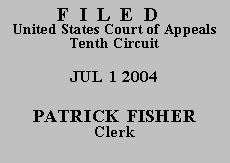

| UNITED STATES OF AMERICA, |
|
to 151 months in prison--96 months to run concurrently with his state sentences and the remaining 55 months to run consecutively. Citing U.S.S.G. § 5G1.3, Defendant claims that the district court erred when it imposed a sentence to run consecutively with his undischarged state sentences. We have jurisdiction under 28 U.S.C. § 1291 and 18 U.S.C. § 3742(a)(3), and affirm.
Defendant pleaded guilty in Utah state court to two counts of sodomy on a child, two counts of aggravated sexual abuse of a child, one count of sexual abuse of a child, and one count of dealing in material harmful to a minor. The charges involved repeated sexual contact with four different minors ranging in age from 5 to 15 over a period of several years. Much of the contact occurred while Defendant operated a daycare center out of his home. He was sentenced on November 7, 2002.
On April 21, 2003, Defendant pleaded guilty in federal court to manufacture of child pornography in violation of 18 U.S.C. § 2251(a). As part of his plea agreement, Defendant stipulated to the following:
Between January 2000, and December 2001, in Washington County, Utah, I . . . did on two occasions knowingly employ, use, persuade, induce, entice, and coerce a minor girl who was under the age of 10 to engage in sexually explicit conduct for the purpose of producing a visual depiction of such conduct. Specifically, I took pictures of the minor girl in sexual[ly] explicit poses while she was attending daycare at my home. The pictures were then scanned into my computer . . . and maintained. . . . Furthermore, I possessed numerous other child pornography depictions on my computer.
Vol. 1 Doc. 16 at 10.
Citing U.S.S.G. § 5G1.3(b), Defendant filed a motion requesting that his federal sentence run concurrently with his undischarged state sentences. The district court denied the motion and imposed a partially consecutive sentence under § 5G1.3(c).
At the time of sentencing on October 6, 2003, § 5G1.3 stated(1):
The parties agree that subsection (a) does not apply. The question before us is whether subsection (b) applies; that is, whether Defendant's state offenses "have
been fully taken into account in the determination of the offense level for the instant offense." Id.
Defendant contends that "§ 5G1.3(b)'s central aim is to ensure that no defendant is punished twice for the same crime," Aplt. Br. at 10, and that his federal sentence should therefore run concurrently with his state sentence because the underlying acts were part of the same course of conduct. He also argues that § 5G1.3(b) applies because his state offenses are reflected in his criminal history score. Both arguments miss the mark.
An offense has been "fully taken into account in the determination of the offense level for the instant offense" when the sentencing court has considered the conduct in enhancing the offense level under § 1B1.3 (Relevant Conduct). See United States v. Johnson, 40 F.3d 1079, 1082-83 (10th Cir. 1994); U.S.S.G. § 5G1.3 (2002), Application Note 2 (providing example of defendant's offense level being enhanced under Relevant Conduct guideline). Here, Defendant was charged federally with manufacturing child pornography. The conduct forming the basis for this charge was his act of photographing a child in the nude. See 18 U.S.C. § 2251(a). Determining his offense level for this offense did not take into account under § 1B1.3 his state offenses involving sexual contact with various minors. Therefore, Defendant's state offenses have not "been fully taken into account in the determination of the offense level for the instant offense."
Defendant's argument that state offenses were considered when calculating his criminal history score is likewise misplaced. By its plain terms, § 5G1.3(b) applies only if state offenses have been "fully taken into account in the determination of the offense level." (emphasis added).
Section 5G1.3(b) does not apply. The district court therefore did not err in choosing to impose a partially consecutive sentence under § 5G1.3(c). We AFFIRM the district court.
ENTERED FOR THE COURT
Harris L Hartz
Circuit Judge
*.After examining the briefs and the appellate record, this panel has determined unanimously that oral argument would not materially assist the determination of this appeal. See Fed. R. App. P. 34(a)(2); 10th Cir. R. 34.1(G). The case is therefore ordered submitted without oral argument. This order and judgment is not binding precedent, except under the doctrines of law of the case, res judicata, and collateral estoppel. This court generally disfavors the citation of orders and judgments; nevertheless, an order and judgment may be cited under the terms and conditions of 10th Cir. R. 36.3.
1.The Guideline was amended on November 1, 2003.